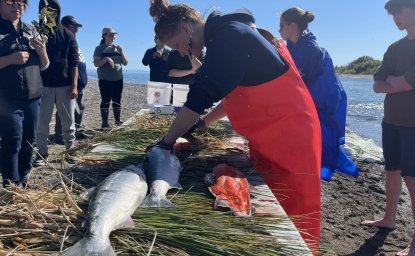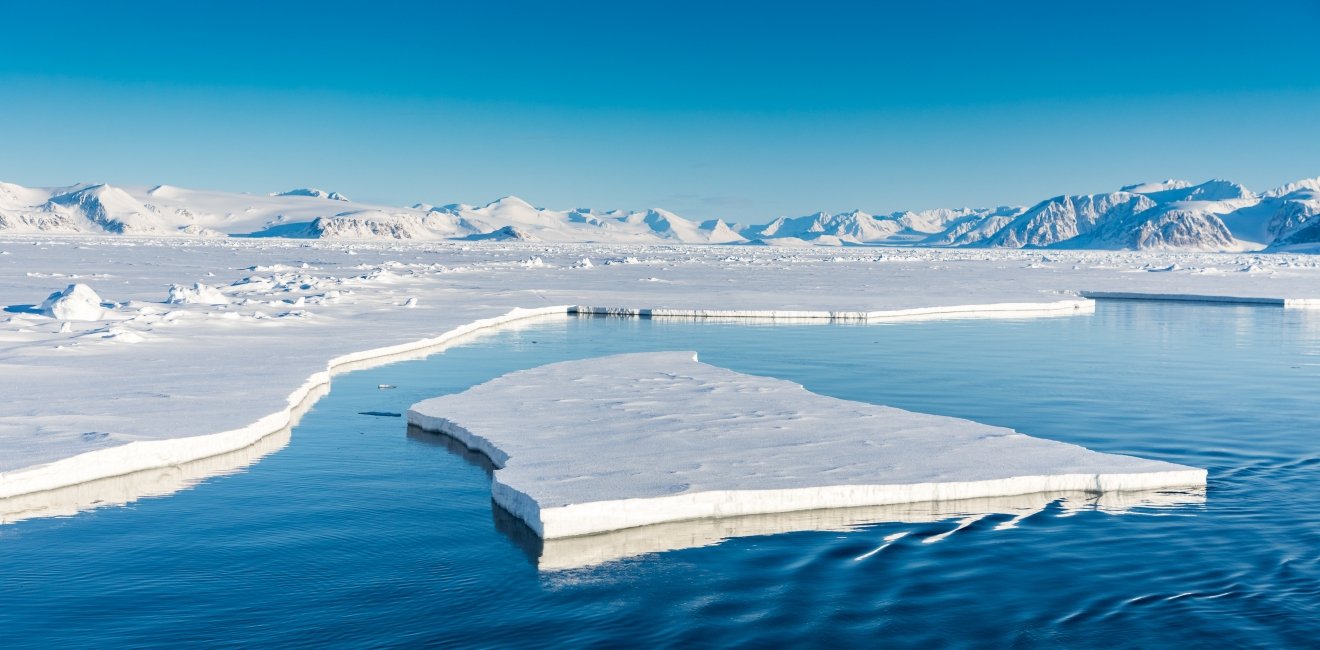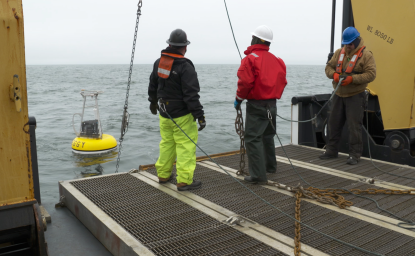For many years economists have recognized the need to value the planet’s ecosystem services to make informed financial and policy decisions based on nature’s contributions to the global economy. While understanding of ecosystem services has improved through increased scientific focus and technological advancements, the acceleration of climate change has continued. Regenerative business models that protect and restore the ecosystems in which they operate have never been more important and offer valuable solutions to address the predicament the planet is experiencing. Nowhere is this truer than for the oceans, Earth’s largest heat and carbon sink. Nonetheless, current estimates indicate that just 1% of global climate finance is dedicated to the oceans, which represents a significant opportunity for capital investment. Now is the time to rethink current climate policies and redirect investment towards an ocean-centric strategy.
As of 2011, the value of the planet’s ecosystem services to humans was estimated at over $120 trillion annually. While this valuation is subject to debate and not thought of as absolute, it is in part limited by the ability to assign a price to those ecosystem services that can be scientifically quantified. In this regard, it has been anecdotally noted that more is known about outer space than about the oceans, and it stands to reason that marine ecosystems are significantly undervalued. Nonetheless, new technologies are rapidly advancing understanding of the oceans through the ability to observe, measure, map, and predict ways that benefit climate mitigation strategies.
In the United States, Alaska has more coastline than the rest of the country combined and accounts for one-third of the nation’s Exclusive Economic Zone. The state is home to some of the largest fisheries in the world, with approximately two-thirds of the nation’s landings harvested off Alaska’s coast. Additionally, Alaska is home to diverse biological ecosystems and world-class wind and tidal renewable energy resources. Coastal tourism is a pillar of the state economy and reflects its status as a preeminent destination for travelers seeking access to numerous pristine natural environments. However, much of Alaska’s natural heritage is threatened by accelerating environmental change due to a rapidly warming Arctic. Declining sea ice, ocean acidification, warming ocean temperatures, melting glaciers, and thawing permafrost have resulted in dramatic changes in the arctic food webs.
Alaska’s seafood industry and its brand has been built on the integration of science-based principles. While far from perfect, the state’s fisheries management is considered to be best in class and globally recognized for its effectiveness in addressing long-term sustainability. In the face of climate change, management at the top levels of major seafood industry stakeholders recognize the need for sound science to navigate the difficult decisions facing fisheries. These challenges go beyond climate and include aging infrastructure, high-energy costs in remote coastal communities, and an aging workforce with a lack of new workers. The COVID-19 pandemic has served to exacerbate these issues, but it has also changed the calculus on the opportunity for technological solutions.
Whereas previously, automation, artificial intelligence, machine learning, and blockchain were viewed as early stage and expensive, largely due to the cost of computer scientists and lack of investments in these areas, these tools are now being recognized as essential components of the industry’s future long-term strategy and viability. Initially, advances in Moore’s law and the commodification of data storage moved from what was once the realm of large government agencies to the general public. During the nascent period, large teams would be required to do what is now considered trivial and efficiently accomplished by a single individual. In the same way businesses have been able to leverage cloud-computing platforms, thereby freeing them to focus on core business, expertise in the architecture that is the foundation of artificial intelligence and deep learning has been commoditized.
Only in the last five years has innovation enabled practical access to such powerful technologies. Expertise in infrastructure, data engineering, data science, data visualization and full stack engineering was once a barrier to entry. Now, fully managed services exist where domain experts can focus solely on the problem space with confidence that the underlying architecture is sound and introduces no upstream error. Like a racecar driver, a pit crew and mechanics handle the building and tuning of the vehicle. Also, businesses have learned not to be limited by geography during the pandemic. Rather, they have embraced remote working arrangements that unlocks a talent pool interested in working on the most important problems facing the planet. When combined with the dramatic reduction in cost to develop sophisticated models, which is estimated to be roughly fifty percent annually, this presents a game changing opportunity.
Novel technologies such as blockchain are breaking down data silos, allowing for transparent, incorruptible, distributed, and decentralized historical records, thereby enhancing interdisciplinary collaboration. Use cases central to Alaska’s blue economy such as improved trade, public health and safety, strengthened sustainability practices, regulatory compliance, and increased consumer trust are all well addressed by distributed ledger technologies. From ocean-to-plate provenance, to frictionless operationally efficient transactions, to new market creation, the fervor in the space among the most motivated engineers, venture funds, academic institutions, governments, and entrepreneurs is self-evident and in the early innings.
Against this backdrop, science and economics is building capacity for valuing ecosystem services. As one example, scientists have attempted to account for why krill populations decline when whales are removed from an ecosystem. Roughly speaking, because whales consume krill, it stands to reason that reducing their predation would increase the krill population – yet, the opposite can occur. Recent research suggests that as whales frolic, they distribute nutrients in the water column through diving, while their fecal plumes fertilize the ocean with significant amounts of nutrients. These activities then spur the growth of phytoplankton, which in turn feed krill, which are then consumed by whales. Furthermore, phytoplankton blooms as a keystone create feeding events for the entire fishery as whales move the baseline nutrients to areas that are otherwise nutrient-depleted regions of the ocean’s surface.
For context, phytoplankton produce nearly half of the oxygen and account for roughly one-third of carbon sequestration on the planet. Water blankets the majority of the planet and provides a vast canvas for the occurrence of plankton blooms, which are roughly equivalent to four Amazon rainforests, and, unlike trees plankton provide an improved climate investment because they cannot burn. However, plankton’s symbiotic relationship with large cetaceans can threaten these ecosystem services. At full capacity, it is estimated that the earth can support a population of 5 million whales, but this number has been reduced to only 1 million. Over the past 40 years, most whale deaths are attributed to humans, due to ship strikes and entanglement.
Witness global powers convening to forge agreements in an attempt to reduce atmospheric emissions and hence mitigate the impacts of global climate change. Clearly, reduction in future atmospheric emissions is important, which is in addition to sequestering anthropogenic carbon within the ocean-atmosphere system. The notion that a solution to the climate dilemma can be engineered through new technologies may be considered ironic because at least a partial, time-tested solution exists, and without the potential for unexpected consequences associated with new engineering approaches; namely, let the whales frolic.
Important advances have been accomplished in calculating the current value of the ecosystem services that whales provide in the form of carbon sequestration, which is estimated at over $80 billion annually worldwide. Each whale is estimated to produce $2 million in ecosystem services over the course of its life. Yet, that amount is based only on carbon sequestration provided and low-balls an average 60-year lifespan. Also, this estimate does not consider the multiplier effect that whales have on fish stocks by increasing the available food within the oceanic trophic chain.
In addition to the role that economists have in pricing services, an important accounting of resources is necessary. Proposing that these services can quite literally be put on the balance sheet of a state or country, it has been advocated that investing in nature-based technologies and solutions can create a marketplace to support ecosystem services. Continuing with the whale example, whales can be tracked with non-invasive sensors, identified by their unique voices, tokenized using blockchain, and their services valued in carbon markets. Carbon offset credits can be traded based on the services rendered. Shipping companies would then have a financial incentive to avoid collision with whales. Motivated entrepreneurs would see opportunities to build solutions to help track and predict migration patterns. Insurance companies could then price in the risk profile of the shipping companies and reward good behavior, or raise premiums based on intelligence captains receive in transit to help safely navigate. New markets could emerge provided there were no longer impunity for injuring these massive gardeners of the sea.
In addition to large cetaceans, mangrove forests, seagrasses, and seaweeds all provide significant ecosystem services including carbon sequestration, nursery habitat for juvenile fish, and removal of excess nitrogen loads. These are all examples of regenerative solutions to erosion and rising sea level. In Alaska, which is home to some of the world’s largest kelp beds, seaweed farming is an emerging industry that could dramatically expand the footprint for kelp ecosystems to the benefit of fisheries and marine ecosystem health. Seaweed requires no arable land, fresh water, fertilizer, and little maintenance during the grow season. Studies have shown a localized reduction of ocean acidification as the crop absorbs carbon. Because it is a fast growing organism, with some kelp species capable of growing two feet per day, seaweed farming offers tremendous potential for generating ecosystem services. Kelp mariculture is also highly scalable, with researchers identifying over 60 million acres of ocean suitable for seaweed farming in Alaska and 6 million acres within 50 miles of a port.
While scientists are actively studying the carbon cycle of sinking seaweed to the seafloor after harvest, other studies indicate a higher value add and a significant multiplier for climate adaptation strategies. For example, the addition of certain kelp species to animal feed, some of which are readily found in Alaska, can reduce methane emissions from livestock by as much as 80%. Consider, too, that methane is known to have a global warming potential of approximately 85 times that of carbon dioxide over a 20-year period. This year, the Biden administration pegged the price of carbon at $51 per ton vs. $1,500 per ton for methane. Further, seaweed provides livestock with superior nutrients that makes them healthier and better tasting.
In addition, seaweed is an excellent fertilizer for agricultural crops. Seaweed has a high content of minerals, vitamins, and enzymes, including naturally occurring growth hormones that account for the rapid growth cycle of seaweed. Pricing and availability currently limit its use to certain high value crops, but greater mariculture production would facilitate regenerative farming practices that could restore soil health and improve the nutrient value of food supply chains. Further, the use of seaweed as a fertilizer is not limited to agricultural crops. As global temperatures warm, large-scale emissions of methane trapped in permafrost across the Arctic pose a major problem that could tip the scales of climate change. In this regard, one solution proposed is to better insulate the permafrost during the seasonally warmer months by increasing tundra growth on the surface through the application of seaweed fertilizers.
Large-scale seaweed farming can be co-located within offshore wind farms and adjacent to other renewable energy resources such as geothermal and tidal energy projects. Alaska’s world-class renewable resource potential is largely a stranded asset, meaning there is little to no electricity demand in remote areas where resources are located. Processing the massive amounts of seaweed biomass into food, feed, fertilizers and biofuel could address this issue, and project development would also benefit from permitting synergies and shared infrastructure costs.
These examples illustrate what is possible through an economic approach that values ocean ecosystem services. By investing in natural aquatic ecosystems, it is possible to slow and perhaps reverse the most severe effects of climate change. Alaska is arguably an ideal location to study and test these methodologies because the ecosystems are pristine and relatively intact compared to other coastal areas. A potential first step would be to inventory the natural environment and ecosystem services provided in Alaska’s coastal waters. Researchers in Alaska have been conducting such work for decades, but an applied approach to address climate change should focus on interdisciplinary outcomes that build on numerous basic research studies. Once inventoried, the ecosystem services could then be valued and assessed through a carbon lifecycle analysis.
Over time, carbon valuation could be expanded to account for multiplier benefits, or by developing new methodologies to value biodiversity. Alaska is home to some of the world’s most diverse cold-water ecosystems. While tropical waters are known for high levels of ecological diversity, cold climate species are recognized for the development of medicines, cosmetics, and nutraceuticals due to high concentrations of bioactive compounds, such as antioxidants, and novel molecular compounds that may promise a cure for cancer or anti-aging therapies. As our understanding of ecosystem services expands, value could be assigned to biodiversity, recognizing unknown and underexplored species and ecosystems as a bank for future research and development.
Inventorying ecosystem services and accounting for their value will require new science-based policy and investment. With ocean-based industry increasingly aware of the need for better science to inform decision-making, it is important that researchers include an economic analysis to address return on investment. Public-private partnerships between industry and academia are mutually beneficial when: 1) industry-based challenges are prioritized and addressed; 2) outcomes are continually quantified against investments; 3) universities provide research at a cost below what industry would otherwise pay and; 4) actionable insights emerging from research serve as inputs that can be engineered into solutions. Recent financing innovations, including blue bonds, corporate social responsibility (CSR), debt-for-nature swaps, and blended financing will further support this transition as governments prioritize blue sustainability as a primary pathway towards carbon sequestration.
Importantly, it must be acknowledged that Alaska is home to 229 federally recognized tribes and 40% of the total U.S. tribal population. In coastal regions, approximately 37% of the population identifies as Alaska Native or American Indian, according to 2020 census data. Coastal Alaska is almost entirely rural and faces a multitude of challenges, not the least of which is being at the forefront of a changing climate. Over 200 Native villages in Alaska are affected to some degree by flooding and erosion made worse by climate change. A significant number of communities depend on fishing for their livelihoods and subsistence to feed their families. These communities and cultures have stewarded the lands and oceans where they live for thousands of years and there is much to be learned from such traditional ecological knowledge. Market mechanisms should be devised to incentivize and fully compensate Alaska Native communities for their stewardship.
Authors




Global Europe Program
The Global Europe Program is focused on Europe’s capabilities, and how it engages on critical global issues. We investigate European approaches to critical global issues. We examine Europe’s relations with Russia and Eurasia, China and the Indo-Pacific, the Middle East and Africa. Our initiatives include “Ukraine in Europe”—an examination of what it will take to make Ukraine’s European future a reality. But we also examine the role of NATO, the European Union and the OSCE, Europe’s energy security, transatlantic trade disputes, and challenges to democracy. The Global Europe Program’s staff, scholars-in-residence, and Global Fellows participate in seminars, policy study groups, and international conferences to provide analytical recommendations to policy makers and the media. Read more

Explore More
Browse Insights & Analysis
Empty Nets: Big Changes in a Great American Fishery

A Personal Account of Well-being and Salmon Systems




